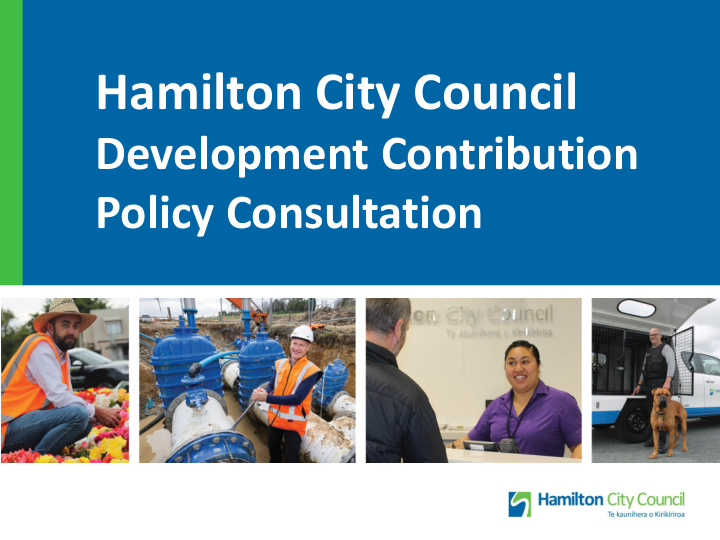



Hamilton City Council Development Contribution Policy Consultation
Why is Council reviewing its Development Contributions Policy • Legislative Requirement • Alignment with the 2018-2028 10-Year Plan • To reflect the changes in Capital Expenditure proposed in the 2018-2028 10-Year Plan • To incorporate other updated inputs to the DC model • With direction from elected members
Key Changes to the Policy • Removal of CBD Remissions • Removal of existing capped charges • Recovery of certain capital expenditure outside the 10-Year Plan • Introduction of capped non-residential charges • Charge residential development contributions by the number of bedrooms • Removal of HDR/Ancillary charge category • Indexing of charges
6 December Council Meeting Resolutions
Introduction of capped non- residential charges • High non-residential charges may supress development in the areas where they apply • We are seeking feedback to what extent caps should be used by council • Submissions supported with evidence are appreciated on this topic
Residential DCs by bedroom DC charges should reflect demand Demand is driven by the number of people in a household Which is very closely related to # bedrooms per household
Residential DCs by bedroom Bedrooms per dwelling (2008 - present) 2696 1878 1268 102 0 500 1000 1500 2000 2500 3000 Four-plus Bed Three Bed Two Bed One Bed
Indexing charges Indexing • Adjusts charges in the model for to account purchasing power of money over time (pegged to inflation in the DC Model • Time value of money – a $100 today is worth more than $100 in 20 years • Increase designed to keep contribution constant in real terms over time • To achieve fairness over time, referred to as “intergenerational equity” • Consistent with LGA “Purpose of DCs” • Recommended to Council by Property Council NZ expert in 2017
Indexing charges Indexing a DC charge - illustration DC charge ($) 2018 2019 2020 2021 2022 2023 2024 2025 2026 2027 2028 2029 2030 2031 2032 2033 Not indexed Indexed
Growth Model • NIDEA Household projections are used to approximate residential demand • Macroeconomic model to approximate non-residential demand • Detailed capacity analysis undertaken to approximate capacity in the city • Allocates growth spatially using historical growth trends, infrastructure and planning constraints
DC Funding Model
Main driver of increased charges Compare DC capex - existing policy vs draft 2018/19 policy $1,000,000 $900,000 Transport $800,000 DC capex $'000 $700,000 Wastewater $600,000 $500,000 Stormwater $400,000 $300,000 Water $200,000 $100,000 Reserves $0 2015-25 DC capex 2018-28 DC capex
DC Funding Model • Calculates a DC charge on a project by project basis • Groups together projects by catchment • Ensures that historical and future cost is shared amongst all developments that benefit from them
Updating inputs Residential Historical Comml/indrl growth 10 YP & 30 YR Historical DC capex growth projections capex revenue projections Historical HIF interest growth free Catchments Cost (GIS) Conversion allocations Blue = factors Updated DC and Growth External Orange = Models review Being finalised Red = Scenario testing DC revenue deferred DC charges
Future Roadmap www.hamilton.govt.nz/dcpolicy2018
Questions Jason Cargo to chair
Hamilton City Council Development Contribution Policy Getting ready to make a submission
How to have your say
Have your say • Councillors want to hear your views. By 30 April 2018 • Here are some tips for an effective submission…
Who is the submission from? • Be clear who the submission is from . Does it represent: – your individual view, – the view of a wider community group, or – a formal response from an organization?
What is your position? • Indicate if you support or oppose the change proposed by Council • Explain the reasons for your views: - Why is the change a concern to you - How will you be impacted? - If you can, support your reasons with data and information (noting the source).
What do you want to happen? • Clearly state what you want to happen: • Who will be affected by what you want to happen? (including who pay for will the cost of infrastructure) • Who wiill benefit from what you want to happen? (include the wider community impact)
How to make it easy to read? Your elected members read many submissions so to ensure your views get across consider the following: - Use simple, everyday words. - Use lists and bullet points. - If you provide additional information consider: o The format. o Clear references to attachments. o Highlight the main points.
Making a verbal submission • If you want to present your key points to Council, you can do this by ticking the box on the submission form to provide a verbal submission. • You will have 2 minutes to speak (if an individual) or 6 minutes (if an organisation). • Elected members may ask you questions. • Use the time to get across your key points. • We will contact you with a time slot for the 14, 15 or 16 May 2018.
Next Steps: Consultation and submissions Formal community consultation 29 March – 30 April 2018 Hamilton.govt.nz/10yearplan 15, 16 (17) May Verbal submissions heard 31 May – 1 June 2018 Council deliberations 28 June 2018 Formal adoption of 10-Year Plan We want to hear from you… Go to Hamilton.govt.nz/10yearplan to make your submission by 30 April 2018
Recommend
More recommend